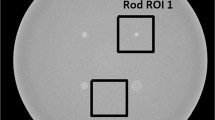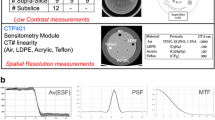Abstract
Background
CT of pediatric phantoms can provide useful guidance to the optimization of knowledge-based iterative reconstruction CT.
Objective
To compare radiation dose and image quality of CT images obtained at different radiation doses reconstructed with knowledge-based iterative reconstruction, hybrid iterative reconstruction and filtered back-projection.
Materials and methods
We scanned a 5-year anthropomorphic phantom at seven levels of radiation. We then reconstructed CT data with knowledge-based iterative reconstruction (iterative model reconstruction [IMR] levels 1, 2 and 3; Philips Healthcare, Andover, MA), hybrid iterative reconstruction (iDose4, levels 3 and 7; Philips Healthcare, Andover, MA) and filtered back-projection. The noise, signal-to-noise ratio and contrast-to-noise ratio were calculated. We evaluated low-contrast resolutions and detectability by low-contrast targets and subjective and objective spatial resolutions by the line pairs and wire.
Results
With radiation at 100 peak kVp and 100 mAs (3.64 mSv), the relative doses ranged from 5% (0.19 mSv) to 150% (5.46 mSv). Lower noise and higher signal-to-noise, contrast-to-noise and objective spatial resolution were generally achieved in ascending order of filtered back-projection, iDose4 levels 3 and 7, and IMR levels 1, 2 and 3, at all radiation dose levels. Compared with filtered back-projection at 100% dose, similar noise levels were obtained on IMR level 2 images at 24% dose and iDose4 level 3 images at 50% dose, respectively. Regarding low-contrast resolution, low-contrast detectability and objective spatial resolution, IMR level 2 images at 24% dose showed comparable image quality with filtered back-projection at 100% dose. Subjective spatial resolution was not greatly affected by reconstruction algorithm.
Conclusion
Reduced-dose IMR obtained at 0.92 mSv (24%) showed similar image quality to routine-dose filtered back-projection obtained at 3.64 mSv (100%), and half-dose iDose4 obtained at 1.81 mSv.





Similar content being viewed by others
References
Brenner DJ, Hall EJ (2007) Computed tomography — an increasing source of radiation exposure. N Engl J Med 357:2277–2284
Schauer DA, Linton OW (2009) NCRP report No. 160, ionizing radiation exposure of the population of the United States, medical exposure — are we doing less with more, and is there a role for health physicists? Health Phys 97:1–5
Brenner DJ (2010) Should we be concerned about the rapid increase in CT usage? Rev Environ Health 25:63–68
Brenner D, Elliston C, Hall E et al (2001) Estimated risks of radiation-induced fatal cancer from pediatric CT. AJR Am J Roentgenol 176:289–296
Pearce MS, Salotti JA, Little MP et al (2012) Radiation exposure from CT scans in childhood and subsequent risk of leukaemia and brain tumours: a retrospective cohort study. Lancet 380:499–505
Mathews JD, Forsythe AV, Brady Z et al (2013) Cancer risk in 680,000 people exposed to computed tomography scans in childhood or adolescence: data linkage study of 11 million Australians. BMJ 346:f2360
Hara AK, Paden RG, Silva AC et al (2009) Iterative reconstruction technique for reducing body radiation dose at CT: feasibility study. AJR Am J Roentgenol 193:764–771
Singh S, Kalra MK, Shenoy-Bhangle AS et al (2012) Radiation dose reduction with hybrid iterative reconstruction for pediatric CT. Radiology 263:537–546
Singh S, Kalra MK, Hsieh J et al (2010) Abdominal CT: comparison of adaptive statistical iterative and filtered back projection reconstruction techniques. Radiology 257:373–383
Willemink MJ, de Jong PA, Leiner T et al (2013) Iterative reconstruction techniques for computed tomography part 1: technical principles. Eur Radiol 23:1623–1631
Katsura M, Matsuda I, Akahane M et al (2012) Model-based iterative reconstruction technique for radiation dose reduction in chest CT: comparison with the adaptive statistical iterative reconstruction technique. Eur Radiol 22:1613–1623
Singh S, Kalra MK, Do S et al (2012) Comparison of hybrid and pure iterative reconstruction techniques with conventional filtered back projection: dose reduction potential in the abdomen. J Comput Assist Tomogr 36:347–353
Hansen NJ, Kaza RK, Maturen KE et al (2014) Evaluation of low-dose CT angiography with model-based iterative reconstruction after endovascular aneurysm repair of a thoracic or abdominal aortic aneurysm. AJR Am J Roentgenol 202:648–655
Chang W, Lee JM, Lee K et al (2013) Assessment of a model-based, iterative reconstruction algorithm (MBIR) regarding image quality and dose reduction in liver computed tomography. Invest Radiol 48:598–606
Smith EA, Dillman JR, Goodsitt MM et al (2014) Model-based iterative reconstruction: effect on patient radiation dose and image quality in pediatric body CT. Radiology 270:526–534
Patino M, Fuentes JM, Hayano K et al (2015) A quantitative comparison of noise reduction across five commercial (hybrid and model-based) iterative reconstruction techniques: an anthropomorphic phantom study. AJR Am J Roentgenol 204:W176–W183
Mehta D, Thompson R, Morton T et al (2013) Iterative model reconstruction: simultaneously lowered computed tomography radiation dose and improved image quality. Med Phys Int J 2:147–155
Sucha D, Willemink MJ, de Jong PA et al (2014) The impact of a new model-based iterative reconstruction algorithm on prosthetic heart valve related artifacts at reduced radiation dose MDCT. Int J Cardiovasc Imaging 30:785–793
Oda S, Utsunomiya D, Funama Y et al (2014) A knowledge-based iterative model reconstruction algorithm: can super-low-dose cardiac CT be applicable in clinical settings? Acad Radiol 21:104–110
Khawaja RDA, Singh S, Blake M et al (2015) Ultra-low dose abdominal MDCT: using a knowledge-based iterative model reconstruction technique for substantial dose reduction in a prospective clinical study. Eur J Radiol 84:2–10
Kim H, Park CM, Song YS et al (2014) Influence of radiation dose and iterative reconstruction algorithms for measurement accuracy and reproducibility of pulmonary nodule volumetry: a phantom study. Eur J Radiol 83:848–857
Yuki H, Utsunomiya D, Funama Y et al (2014) Value of knowledge-based iterative model reconstruction in low-kV 256-slice coronary CT angiography. J Cardiovasc Comput Tomogr 8:115–123
Kaasalainen T, Palmu K, Lampinen A et al (2015) Limiting CT radiation dose in children with craniosynostosis: phantom study using model-based iterative reconstruction. Pediatr Radiol 45:1544–1553
Li K, Tang J, Chen G-H (2014) Statistical model based iterative reconstruction (MBIR) in clinical CT systems: experimental assessment of noise performance. Med Phys 41:041906
Boone JM, Strauss KJ, Cody DD et al(2011) Size-specific dose estimates (SSDE) in pediatric and adult body CT examinations (report 204). American Association of Physicists in Medicine, College Park
Goske MJ, Strauss KJ, Coombs LP et al (2013) Diagnostic reference ranges for pediatric abdominal CT. Radiology 268:208–218
Deak PD, Smal Y, Kalender WA (2010) Multisection CT protocols: sex- and age-specific conversion factors used to determine effective dose from dose-length product. Radiology 257:158–166
Funama Y, Taguchi K, Utsunomiya D et al (2011) Combination of a low-tube-voltage technique with hybrid iterative reconstruction (iDose) algorithm at coronary computed tomographic angiography. J Comput Assist Tomogr 35:480–485
Love A, Olsson ML, Siemund R et al (2013) Six iterative reconstruction algorithms in brain CT: a phantom study on image quality at different radiation dose levels. Br J Radiol 86:20130388
Mayo-Smith WW, Gupta H, Ridlen MS et al (1999) Detecting hepatic lesions: the added utility of CT liver window settings. Radiology 210:601–604
Schindera ST, Odedra D, Raza SA et al (2013) Iterative reconstruction algorithm for CT: can radiation dose be decreased while low-contrast detectability is preserved? Radiology 269:511–518
Yoon JH, Lee JM, Yu MH et al (2014) Comparison of iterative model-based reconstruction versus conventional filtered back projection and hybrid iterative reconstruction techniques: lesion conspicuity and influence of body size in anthropomorphic liver phantoms. J Comput Assist Tomogr 38:859–868
Funama Y, Taguchi K, Utsunomiya D et al (2014) Image quality assessment of an iterative reconstruction algorithm applied to abdominal CT imaging. Phys Med 30:527–534
Gay F, Pavia Y, Pierrat N et al (2014) Dose reduction with adaptive statistical iterative reconstruction for paediatric CT: phantom study and clinical experience on chest and abdomen CT. Eur Radiol 24:102–111
Husarik DB, Alkadhi H, Puippe GD et al (2015) Model-based iterative reconstruction for improvement of low-contrast detectability in liver CT at reduced radiation dose: ex-vivo experience. Clin Radiol 70:366–372
Vardhanabhuti V, Loader R, Roobottom CA (2013) Assessment of image quality on effects of varying tube voltage and automatic tube current modulation with hybrid and pure iterative reconstruction techniques in abdominal/pelvic CT: a phantom study. Invest Radiol 48:167–174
Yasaka K, Katsura M, Akahane M et al (2013) Model-based iterative reconstruction for reduction of radiation dose in abdominopelvic CT: comparison to adaptive statistical iterative reconstruction. Springerplus 2:209
Acknowledgments
We thank Young Mi Chun, CT clinical scientist manager, Philips Healthcare Korea, for technical support. We thank Allison Alley for language consultation and editing.
Author information
Authors and Affiliations
Corresponding author
Ethics declarations
Conflicts of interest
None
Rights and permissions
About this article
Cite this article
Ryu, Y.J., Choi, Y.H., Cheon, JE. et al. Knowledge-based iterative model reconstruction: comparative image quality and radiation dose with a pediatric computed tomography phantom. Pediatr Radiol 46, 303–315 (2016). https://doi.org/10.1007/s00247-015-3486-6
Received:
Revised:
Accepted:
Published:
Issue Date:
DOI: https://doi.org/10.1007/s00247-015-3486-6




